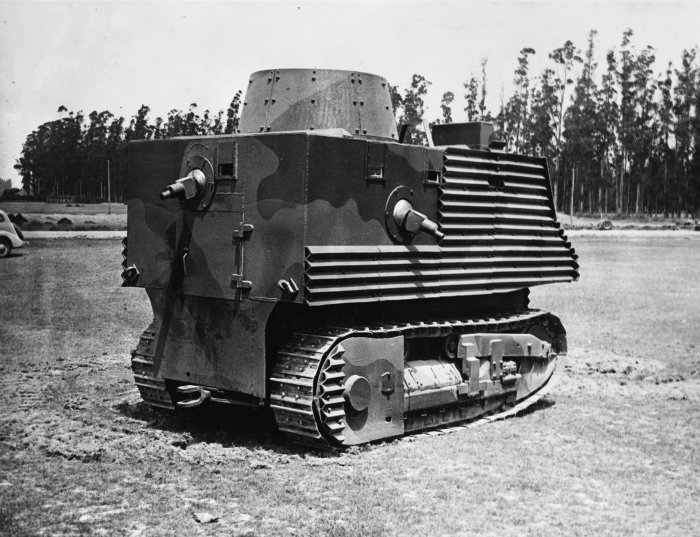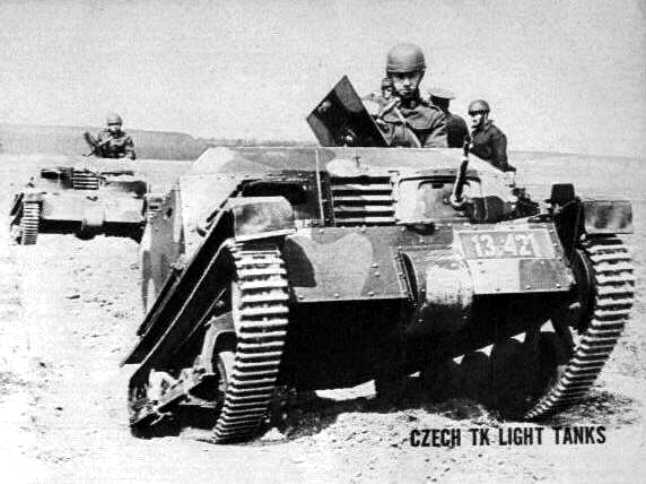Panther. Tiger. T-34. Sherman. Everyone knows those tanks. Why? Because they were the results of successful development. Some were expertly made, others were produced in numbers noone could match, but they were all good tanks.
Sometimes however the development doesn't go as planned and the result is... not so good. Some tanks were plagued with too many problems, some were barely functional and some were simply a disaster. Those form the tank Hall of Shame and today we are going to have look at some of the worst tanks ever made.
Bob Semple
This one is a classic - perhaps the worst "tank" seriously made. In the past, there have been many improvised vehicles, made by groups without access to proper tank facilities, some have been very successful in their role (Kubus, the Odessa tanks etc.), but this is just plain bad.
Bob Semple was named after Robert "Bob" Semple, the minister of public works in New Zealand (who also acted as an ad hoc minister of defense), who decided it would be a great idea for New Zealand not to rely on British protection and make an "armored vehicle" instead. And because he was a very "humble" man, he ordered the vehicle to be named after him. Bob Semple tank was based on agricultural Catterpillar tractors, it was crude construction, "armored" with 12mm thick plates, that was to carry 8 crewmembers. It was slow, the overstressed suspension broke down all the time (they "upgraded" the weight of the original tractor to 25 tons), while powering it with the original 95hp engine, it was top-heavy so it tended to topple everytime it climbed a slope, the ergonomics were a nightmare (one of the gunners actually had to lie on the running engine with only a matress protecting him), the armor could be punched thru with a heavy machinegun and the armament (Bren HMG's) was obsolete. Only like 4 were made, they were used on "military parades" for morale purposes only and instead of inspiring, they became a laughing stock for the whole country. The army got rid of them soon after.
More on Bob Semple:
http://en.wikipedia.org/wiki/Bob_Semple_tank
Valiant
Another classic disaster from 1943, this time from the British themselves. It is still kept in the Bovington museum as a reminder how not to build a tank. The whole point of the tank was to make the frontal armor as thick as possible without having too much weight, which resulted in a terrible, terrible tank. The weight distribution overstrained the whole suspension too much, concerns about its fragility were never addressed. The tank was trialled in 1945 and for those who haven't watched the brilliant Operation Think Tank show, here's what was wrong with it, as told by D.Fletcher (a recently retired Bovington museum curator and British tank expert):
- if your foot slipped accidentally between pedals, the tank was so badly ergonomic the only way to get you out of there was to remove your foot
- the driver's hatch was so badly designed that the sharp rims did hit the driver in the back of the skull everytime the tank went over broken terrain
- if you pushed the gear lever too far back, the only way to get it back was with a crowbar
Either way, during the tests, the tank went only few miles before the commanding officer decided it's not worth it and had the whole project cancelled. The tank was kept then in a museum and occasionally, it was shown to a bunch of British officers in training for them to find as many mistakes as they could.
More on Valiant:
http://en.wikipedia.org/wiki/Valiant_tank
Asad Babil (Lion of Babylon)
Lion of Babylon was an Iraqii tank, designed during early 80's. Basically, it was a dowgraded cheap copy of an already downgraded T-72M export model, which in turn was a cheap copy of the regular early model Soviet T-72 tanks. The Iraqui "upgrades" consisted of cheaper armor, bolted on armor iron armor plates (completely useless), removed electronics and wrong shells being used (it is believed that the Russians cheated the Iraqi and sold them APDS shells with cores made of mild steel (!) instead of tungsten alloy. Ironically, this terrible tank performed not so badly in the Iran-Iraq war, but during the Gulf war, it got torn to pieces by the Americans.
More:
http://en.wikipedia.org/wiki/Asad_Babil
Panzer 68
Panzer 68 was a Swiss tank from the 60's. It isn't a bad design by itself, but when it was introduced, it was discovered that it has significant design flaws and bugs. These included:
- faulty non-functional NBC protection
- gearbox not allowing to properly shift to reverse when the tank is moving
- radios interfered with turret control, causing the turret twitch randomly when the radio operated at full power
- switching on the heating system could cause a gun to fire a round by itself (luckily, this was discovered before an accident could happen)
This led to a huge scandal in Swiss army, resulting in minister of defense's resignation. The newspapers at that time ironically stated that "the tank is more dangerous than it would seem". Eventually, these flaws were fixed during an upgrade program.
More:
http://en.wikipedia.org/wiki/Panzer_68
Tančík vzor 1933
Tančík vzor 1933 (Tankette, 1933 pattern) was a copy of one of the Carden-Lloyd tankettes. It serves as an example how NOT to develop tanks. The copied tankette was originally bought in late 20's in order to serve as a lightly armored mobile machinegun nest, but it was decided to rename it to "tančík" and make it a "real fighting vehicle". The army trialed it hated it, citing low protection, insufficient armament, unreliability and bad ergonomics as the reasons they do NOT want it and that it's totally useless as a recon vehicle because when driving buttoned up, the crew can't see shit. The crews also had trouble in communicating, the machinegun had a narrow field of fire and the gunner couldn't fire it accurately if going faster than 10km/h. But politics intervened and in the end like 70 were made. They were actively used to suppress the nazi uprisings in the Czech border regions and later made their way to various places.
Naturally, there were many more terrible tanks developed.
Honorable mentions: the M551 Sheridan that literally melted under fire, Russian early superheavy tanks (T-35, T-100, SMK) for being completelly useless and broke down all the time, naturally their French counterparts (Char 2C - equally as useless) or for example the Covenanter.
Contrary to popular belief however, Japanese tanks weren't that bad, they were perfectly adequate for the task they were designed to do (fighting the essentially medieval Chinese army). Of course, few could slug it out with the Sherman but at the end of the war, heavier designs started to emerge.











